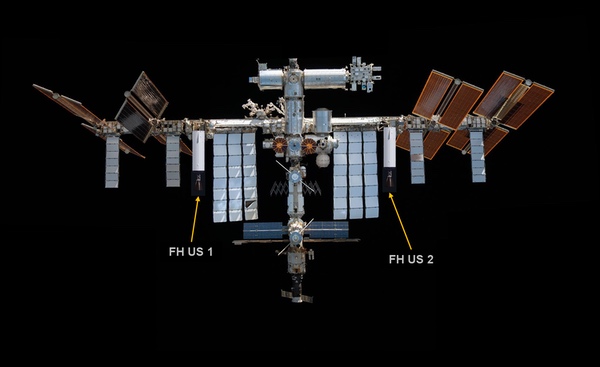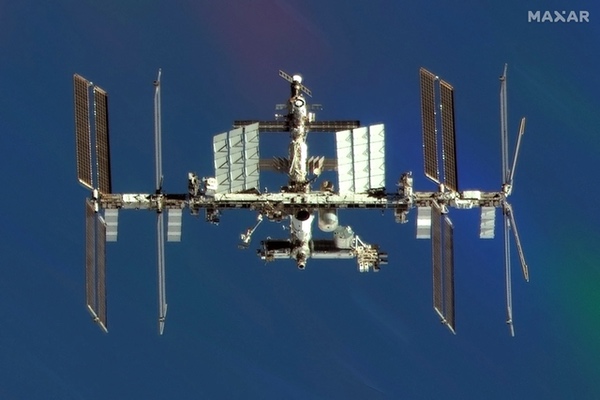For the ISS, to be or not to be?by Ajay Kothari
|
| It could be taken to 800-kilometer orbit and just stored as a world treasure with minimal maintenance for one more generation at least… What is the hurry? |
Rick Tumlinson makes a similar case in another op-ed, also in Space News. As he rightly says, it is indeed a travesty that the ablest space company, SpaceX, is tasked with destroying the greatest space structure. What a conundrum! What a dichotomy!
It could be taken to 800-kilometer orbit and just stored as a world treasure with minimal maintenance for one more generation at least, and then let them decide, after new technologies have been developed by then. What is the hurry? As a worst-case scenario, even with no (or minimal) maintenance, it could remain as a dormant historic piece, similar to the recommendation #5 of Tumlinson. It would cost the same to deorbit as to reorbit, or even less as described herein.
Another scenario maybe to have government and commercial entities share the cost of maintaining it at 800 kilometers, perhaps as a waystation to the Moon, sort of like in 2001: A Space Odyssey, and maybe as fuel depot. At $10,000 per pound to LEO, the 450-ton ISS's value is in its position and velocity. It would be asinine to lose that. The cost of $9–10 billion is perhaps a bean-counter argument, but it’s much worse to lose an incredible historic treasure that should not be measured in dollars and cents. Civilizations are not always built on bean counting. There has to be other considerations or we would not have any national parks, just a takeover by salivating land developers showing large bottom lines.
Two flights of Falcon Heavy (FH) with its center stage expended but the side boosters recoveres would cost about $100-125 million each (FH all expendable costing about $150 million as of a 2022 quote.) The payload to LEO capacity of this option is 54 tons. The upper stages that carry no payload but that much additional propellant each instead would have 54 tons of propellant left over in LEO. The upper stage would have to have 50% longer tanks to carry a maximum of about 147 tons and minimum of 133 tons of propellant instead of the standard 93 tons. The mission to LEO remains unchanged. We are willing to spend billions on so many other things, but cannot spend half a billion for this immense national treasure?
Let us play the numbers game. Here they are for Hohmann transfer from 220 nautical miles (407 kilometers) and 52-degree inclination that ISS is in to an 800-kilometer orbit with the same inclination as suggested:
 |
The ratio of payload to ISS orbit versus LEO is approximately 58%. Hence we would have 31 tons of propellant left over in the upper stage by the time it reaches ISS instead of the 54 tons mentioned above. As described above, with two flights of Falcon Heavy, we would have 62 tons of propellant in two ten-ton dry weight upper stages. To the 213 meters per second Delta V (TotDelV in the table above) is added a 15% margin for uncertainty to compute the propellant required for the transport from the 407-kilometer ISS orbit to the almost benign 800-kilometer orbit. This is given below for the Merlin 1Dv engine upper stage as it is currently for FH.
 |
The total of 34 tons of propellant needed, shown in the above table, is substantially below the 62 tons available with the two upper stages now attached to appropriate truss points on the ISS (based on the load-bearing strength and center-of-gravity considerations that the author is not knowledgeable about.) The diameter of each upper stage is 3.7 meters, which would be about right for possible points of attachment as shown in the figure below.
 (ISS picture courtesy NASA) |
With almost 500 tons of initial mass and 95 tons thrust now throttled down to 40% or 38 tons for each upper stage, the acceleration of the system would be ~0.15 meters per second squared. Studies are needed to determine if this would or would not cause any vibration issues.
| It needs to be combined with the political will at NASA, National Space Council, Congress, and the White House. One hopes it does so before the point of no return, the Point Nemo. |
The point is that this is eminently doable and at much smaller cost than what has been quoted for deorbiting and then destroying it, $843 million, with parts thereof sinking at “Point Nemo” in the Pacific Ocean. (Captain Nemo would not agree, and neither would Jules Verne nor multitude of people here on Earth!) One need only see the animation of the ISS assembly to appreciate the incredible effort that went into assembling it in such a hostile, unforgiving environment with astronauts and cosmonauts doing multitudes of EVAs to put the modules together, starting from 1998 with Zarya and Unity. It is and was an astounding effort that should be conserved for many future generations as a source of inspiration, not just the next generation. One can be sure, instead, that the future generations would call us idiots for destroying such a monument.
It is not important at this junction as to whether this is done by two Merlin 1Dv engines or many smaller ones of some other potential solution, strategically placed, The Delta V required does not change and nor does the analogous physics. It just says that the answer is within reach. It needs to be combined with the political will at NASA, National Space Council, Congress, and the White House. One hopes it does so before the point of no return, the Point Nemo.
Note: we are now moderating comments. There will be a delay in posting comments and no guarantee that all submitted comments will be posted.
